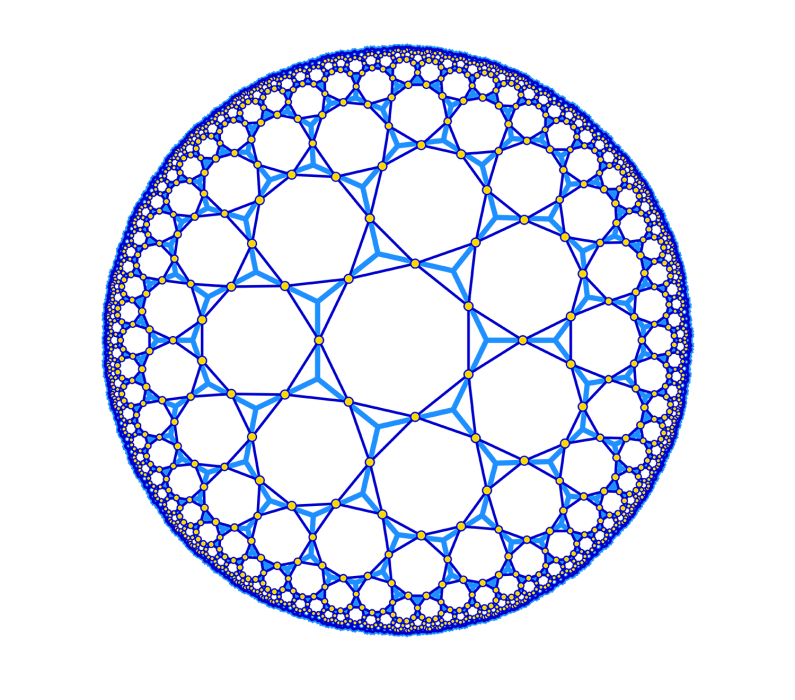
Hyperbolic Poincare Projection
The field of circuit QED has emerged as a rich platform for both quantum computation and quantum simulation. Lattices of coplanar waveguide (CPW) resonators realize artificial photonic materials in the tight-binding limit. Combined with strong qubit-photon interactions, these systems can be used to study dynamical phase transitions, many-body phenomena, and spin models in driven-dissipative systems. These waveguide cavities are uniquely deformable and can produce lattices and networks which cannot readily be obtained in other systems, including periodic lattices in a hyperbolic space of constant negative curvature, and the one-dimensional nature of CPW resonators leads to degenerate flat bands. In our lab, we build experimental implementations of these systems using superconducting circuits.
Postdoc and graduate student positions available! Send email to: akollar@umd.edu
Alicia Kollár Wins Sloan Fellowship
https://umdphysics.umd.edu/about-us/news/department-news/1774-kollar-sloan.html
JQI Fellow Kollár Awarded Sloan Research Fellowship
JQI Fellow Alicia Kollár has been awarded a prestigious 2022 Sloan Research Fellowship. This award is given to early career researchers by the Alfred P. Sloan Foundation to recognize distinguished performance and the potential to make substantial contributions to their field. Each fellowship provides $75,000 to support the fellow’s research over two years.
Enhancing Simulations of Curved Space with Qubits
One of the mind-bending ideas that physicists and mathematicians have come up with is that space itself—not just objects in space—can be curved. When space curves (as happens dramatically near a black hole), sizes and directions defy normal intuition. Understanding curved spaces is important to expanding our knowledge of the universe, but it is fiendishly difficult to study curved spaces in a lab setting (even using simulations). A previous collaboration between researchers at JQI explored using labyrinthine circuits made of superconducting resonators to simulate the physics of certain curved spaces. In particular, the team looked at hyperbolic lattices that represent spaces—called negatively curved spaces—that have more space than can fit in our everyday “flat” space. Our three-dimensional world doesn’t even have enough space for a two-dimensional negatively curved space. Now, in a paper published in the journal Physical Review Letters on Jan. 3, 2022, the same collaboration between the groups of JQI Fellows Alicia Kollár and Alexey Gorshkov, who is also Fellow of the Joint Center for Quantum Information and Computer Science, expands the potential applications of the technique to include simulating more intricate physics. They’ve laid a theoretical framework for adding qubits—the basic building blocks of quantum computers—to serve as matter in a curved space made of a circuit full of flowing microwaves. Specifically, they considered the addition of qubits that change between two quantum states when they absorb or release a microwave photon—an individual quantum particle of the microwaves that course through the circuit.
Kollár Receives National Science Foundation CAREER Award
JQI Fellow Alicia Kollár has received a prestigious Faculty Early Career Development (CAREER) award from the National Science Foundation (NSF) for a proposal aimed at developing a new window into the physics of particles interacting inside of materials and performing educational outreach. The award will provide $675,000 of funding over five years for her proposal titled “Engineering Interacting Photons in Superconducting-Circuit Lattices.” Kollár will use the funds to investigate new physics that might be revealed by making particles of light (called photons) behave more like particles of matter (like electrons). Her plan is to tailor environments for photons by combining superconducting components into specialized circuits.
"Gap Sets for the Spectra of Cubic Graphs" Accepted in a Mathematical Journal
Our recent paper "Gap Sets for the Spectra of Cubic Graphs" which harnesses condensed-matter-physics methods for computing tight-binding band structures to tackle questions about the possible spectra of adjacency operators on 3-regular graphs was accepted for publication in a new journal of the American Mathematical Society: "Communications of the AMS." The article will feature in the inaugural volume of CAMS.
Kollár Receives Air Force Young Investigator Grant
JQI Fellow Alicia Kollár has been awarded a grant by the Air Force’s Young Investigator Research Program (YIP). She is one of 36 early-career researchers around the US to receive the three-year, $450,000 award.
Mind and Space Bending Physics on a Convenient Chip
Thanks to Einstein, we know that our three-dimensional space is warped and curved. And in curved space, normal ideas of geometry and straight lines break down, creating a chance to explore an unfamiliar landscape governed by new rules. Spaces that have different geometric rules than those we usually take for granted are called non-Euclidean. Physicists are interested in new physics that curved space can reveal, and non-Euclidean geometries might even help improve designs of certain technologies. One type of non-Euclidean geometry that is of interest is hyperbolic space. Even a two-dimensional, physical version of a hyperbolic space is impossible to make in our normal, “flat” environment. But scientists can still mimic hyperbolic environments to explore how certain physics plays out in negatively curved space. In a recent paper in Physical Review A, a collaboration between Kollár’s research group and JQI Fellow Alexey Gorshkov’s group presented new mathematical tools to better understand simulations of hyperbolic spaces. The research builds on Kollár’s previous experiments to simulate orderly grids in hyperbolic space by using microwave light contained on chips. Their new toolbox includes what they call a “dictionary between discrete and continuous geometry” to help researchers translate experimental results into a more useful form. With these tools, researchers can better explore the topsy-turvy world of hyperbolic space.
Extremal Lattices
New mathematical physics result is on the arXiv (2005.05379), including unique quasi-one-dimensional lattices with the largest possible bang gaps.
Line-Graphs paper accepted to Communications in Mathematical Physics
Our mathematical-physics paper on the connection between circuit QED lattices and combinatorial graph theory (Line-Graph Lattices: Euclidean and Non-Euclidean Flat Bands and Implementations in Circuit QED) was accepted fro Publication in a mathematical journal: "Communications in Mathematical Physics".